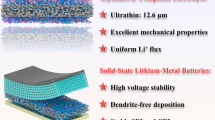Abstract
All-solid-state lithium sulfur battery is considered as one of the most promising candidates for the future application due to high theoretical energy density and enhanced safety. However, the all-solid-state lithium sulfur battery based on Li7P3S11 solid electrolyte has serious interface issues between electrode and solid electrolyte. The reaction of lithium metal and Li7P3S11 solid electrolyte would form a layer without lithium-ion conducting, which could impend the lithium-ion transfer and transport during cycling and causes increase of internal resistance and capacity fading. Herein, we introduce a solid electrolyte Li7P3S11 with BN doping for the all-solid-state lithium sulfur battery. The BN nanoflakes could partially isolate the Li7P3S11 solid electrolyte and lithium metal, thus improving the interfacial compatibility of electrode and electrolyte. With BN doped Li7P3S11 used as solid electrolyte, the all-solid-state Li/S battery exhibits an enhanced electrochemical performance with better cycling stability and higher Coulombic efficiency.






Similar content being viewed by others
References
P. Geng, S. Zheng, H. Tang, R. Zhu, L. Zhang, S. Cao, H. Pang, Transition metal sulfides based on graphene for electrochemical energy storage. Adv. Energy Mater. 8, 1703259 (2018)
X. Guo, Y. Zhang, F. Zhang, Q. Li, D. Anjum, H. Liang, C. Liu, Y. Liu, H. Alshareef, H. Pang, A novel strategy for the synthesis of highly stable ternary SiO x composites for Li-ion-battery anodes. J. Mater. Chem. A 7, 15969–15974 (2019)
Y. Ru, S. Zheng, H. Xue, H. Pang, Different positive electrode materials in organic and aqueous systems for aluminium ion batteries. Energy 21, 24 (2019)
Y. Zheng, S. Zheng, H. Xue, H. Pang, Metal–organic frameworks for lithium–sulfur batteries. J. Mater. Chem. A. 7, 3469–3491 (2019)
A. Manthiram, Y. Fu, Y. Su, Challenges and prospects of lithium–sulfur batteries. Acc. Chem. Res. 46, 1125–1134 (2012)
Y. Yin, S. Xin, Y. Guo, J. Wan, Lithium–sulfur batteries: electrochemistry, materials, and prospects. Angew. Chem. Int. Ed. 52, 13186–13200 (2013)
A. Manthiram, S. Chung, C. Zu, Lithium–sulfur batteries: progress and prospects. Adv. Mater. 27, 1980–2006 (2015)
A. Unemoto, S. Yasaku, G. Nogami, M. Tazawa, M. Taniguchi, M. Matsuo, T. Ikeshoji, S. Orimo, Development of bulk-type all-solid-state lithium-sulfur battery using LiBH4 electrolyte. Appl. Phys. Lett. 105, 083901 (2014)
M. Chen, S. Adams, High performance all-solid-state lithium/sulfur batteries using lithium argyrodite electrolyte. J. Solid State Electrochem. 19, 697–702 (2015)
M. Nagao, A. Hayashi, M. Tatsumisago, Electrochemical performance of All-solid-state Li/S batteries with sulfur-based composite electrodes prepared by mechanical milling at high temperature. Energy Technol. 1, 186–192 (2013)
R. Xu, X. Xia, Z. Yao, X. Wang, C. Gu, J. Tu, Preparation of Li7P3S11 glass-ceramic electrolyte by dissolution-evaporation method for all-solid-state lithium ion batteries. Electrochim. Acta 219, 235–240 (2016)
S. Ito, M. Nakakita, Y. Aihara, T. Uehara, N. Machida, A synthesis of crystalline Li7P3S11 solid electrolyte from 1, 2-dimethoxyethane solvent. J. Power Sources 271, 342–345 (2014)
S. Teragawa, K. Aso, K. Tadanaga, A. Hayashi, M. Tatsumisago, Liquid-phase synthesis of a Li3PS4 solid electrolyte using N-methylformamide for all-solidstate lithium batteries. J. Mater. Chem. A 2, 5095–5099 (2014)
S. Wenzel, D. Weber, T. Leichtweiss, M. Busche, J. Sann, J. Janek, Interphase formation and degradation of charge transfer kinetics between a lithium metal anode and highly crystalline Li7P3S11 solid electrolyte. Solid State Ionics 286, 24–33 (2016)
S. Wenzel, S. Randau, T. Leichtwei, D. Weber, J. Sann, W. Zeier, J. Janek, Direct observation of the interfacial instability of the fast-ionic conductor Li10GeP2S12 at the lithium metal anode. Chem. Mater. 28, 2400–2407 (2016)
A. Hayashi, H. Muramatsu, T. Ohtomo, S. Hama, M. Tatsumisago, MOy (M = Fe, Zn, and Bi) nanoparticles. J. Mater. Chem. A 1, 6320–6326 (2013)
R. Xu, F. Han, X. Ji, X. Fan, J. Tu, C. Wang, Interface engineering of sulfide electrolytes for all-solid-state lithium batteries. Nano energy 53, 958–966 (2018)
C. Zhi, Y. Bando, C. Tang, H. Kuwahara, D. Golberg, Large-scale fabrication of boron nitride nanosheets and their utilization in polymeric composites with improved thermal and mechanical properties. Adv. Mater. 21, 2889–2893 (2009)
S. Arya, A. D’amico, Preparation, properties and applications of boron nitride thin films. Thin Solid Films 157, 267–282 (1988)
A. Hayashi, T. Ohtomo, F. Mizuno, K. Tadanaga, M. Tatsumisago, All-solid-state Li/S batteries with highly conductive glass–ceramic electrolytes. Electrochem. Commun. 5, 701–705 (2003)
R. Xu, X. Xia, X. Wang, Y. Xia, J. Tu, Tailored Li2S–P2S5 glass-ceramic electrolyte by MoS2 doping, possessing high ionic conductivity for all-solid-state lithium sulfur batteries. J. Mater. Chem. A 5, 2829–2834 (2017)
Acknowledgements
The authors acknowledge funding support from 1000 Talent Plan program (No. 31370086963030), research projects from Shandong Province (2018JMRH0211, 2017CXGC1010 and 2016GGX104001), Taishan Scholar Program (11370085961006), the National Science Foundation of Shandong Province (ZR2017MEM002), and the Fundamental Research Funds of Shandong University (201810422046, 2017JC010, 2017JC042, and 2016JC005).
Author information
Authors and Affiliations
Corresponding author
Additional information
Publisher's Note
Springer Nature remains neutral with regard to jurisdictional claims in published maps and institutional affiliations.
Electronic supplementary material
Below is the link to the electronic supplementary material.
Rights and permissions
About this article
Cite this article
Xu, X., Wang, L., Fei, H. et al. Boron nitride doped Li7P3S11 solid electrolyte with improved interfacial compatibility and application in all-solid-state Li/S battery. J Mater Sci: Mater Electron 30, 19119–19125 (2019). https://doi.org/10.1007/s10854-019-02267-z
Received:
Accepted:
Published:
Issue Date:
DOI: https://doi.org/10.1007/s10854-019-02267-z




